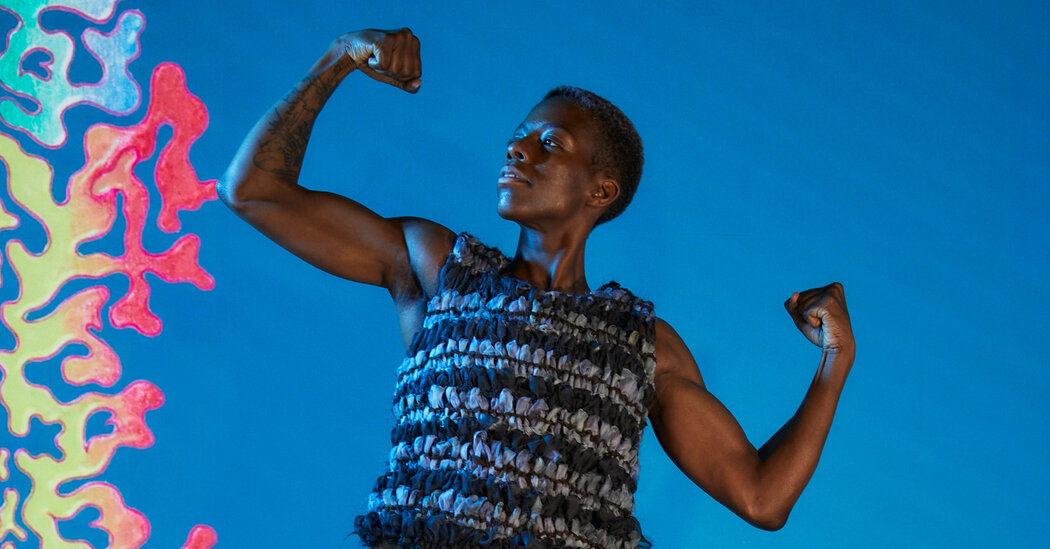When fashion designers, as they often do, allude to women’s strength as an inspiration for the clothes they make, they tend to have in mind their customers’ emotional resilience rather than their bench-pressing prowess. But on the runway at the New York-based brand Collina Strada’s fall 2024 show last month, one model — dressed in a woven sleeveless top and lace-lined athletic shorts — proudly flexed her arms, and another, wearing a floral-print shorts set, did bicep curls with dumbbells made with kabocha squashes (a reference to a photograph of a woman in Nepal weight lifting with pumpkins, explained the line’s creative director, Hillary Taymour, 36). Combining traditionally feminine motifs like frills and flowers with nods to the gym, the collection seems to poke fun at the idea that femininity and strength could ever be seen as opposing forces. Underscoring the point, a third model effortlessly carried her baby up and down the catwalk with one arm.
Taymour is not alone this year in highlighting women’s physical strength as a source of power. The film “Love Lies Bleeding,” released earlier this month, stars Kristen Stewart as a reclusive gym manager who falls in love, and goes on a vengeful crime spree, with a female bodybuilder; the new novel “Headshot,” by Rita Bullwinkel, follows the lives of eight teenage girls who each find a sense of agency through their careers as competitive boxers. But this celebration of female brawn feels particularly notable in the fashion world, which has long prized waifish bodies over athletic ones. A recent advertisement for the British designer Stella McCartney’s Adidas sportswear range shows the model and CrossFit Games athlete Reegan Finkel — whose muscular physique contrasts with the leaner bodies of previous campaigns — lifting weights in a shimmering mauve leotard. The New York-based designer Emily Dawn Long featured a pair of underwear hand-beaded with the logo of the boxing brand Everlast — a riposte to the apocryphal metal chastity belts of yore — in her fall collection. And as part of its offering, the New York-based avant-garde clothing project Women’s History Museum included high heels adorned with leather boxing gloves. For her collection, Taymour and her team consulted “ethically built-up bodybuilder types,” she says, in order to accurately embody a spirit of physical strength in the clothes.
These collections aren’t entirely without precedent: In 2017, the fashion photographer Steven Klein shot the female bodybuilder Joelle Lombardi for Interview magazine; in 2021, as part of his spring couture collection for the French house Schiaparelli, the designer Daniel Roseberry presented dresses sculpted to suggest bulging abs and deltoids. But the ubiquity of the focus on bodily power feels new. The New York-based costume and fashion historian Shelby Ivey Christie, 32, credits this, in part, to a wider cultural shift, she says, as “the definition of what’s beautiful and what’s feminine are broadened to include more athletic body types.” She points to recent fashion magazine covers featuring professional athletes like the tennis player Coco Gauff and the gymnast Simone Biles. But as much as these recent displays of muscle on the runways are a statement of inclusivity and strength, they can also be seen as a form of defense. “We’re in conversations about Roe v. Wade being overturned, the United States v. Rahimi,” says Christie, referring to the legal battles over the right to abortion and the government’s ability to disarm people who are under restraining orders for domestic abuse. “There are a lot of concerns,” she continues, “with women’s safety and bodies.”
Those concerns were front of mind this season for the Brooklyn-based designer Willy Chavarria, 56, whose collection was accompanied by a film that showed models such as Paloma Elsesser and Dilone in various communal spaces, including a home gym, where members of the cast are seen bench-pressing. “The entire story is about the need to keep ourselves safe from harm but also, even more important, the need to keep one another safe,” Chavarria says. While the garments most traditionally associated with women, dresses and skirts, tend to either cling to or hang loosely from the body, Chavarria invoked the more structured forms of men’s wear in his runway collection, presenting angular blazers and roomy yet tailored sportswear — garments designed, he says, to provide protection and add bulk. “There’s a territorial aspect to a lot of my work, particularly when it comes to volume,” he says. “Reclaiming that presence in the world is very important, especially for people who are marginalized.” And there is, of course, no more literal way to take up space and to hold ground than with one’s body — the stronger the better.







